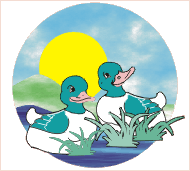 




|
Feeding Ducks
Feeding ducks is very easy.
If your birds have access to the garden to forage
for their own food, you will find they will provide most of their needs for themselves.
However, to improve laying and egg size, it is important to give extra feed to the birds
in the shed at night.
Modern technology has given rise to completely
balanced feed rations which provide the birds with all their nutritional needs. These
feeds usually come in the form of pellets which, if supplemented occasionally with a
little grain, will keep your birds fit, healthy and happy with little effort on your part.
Extra greenstuffs can often be had in the form of lettuce leaves obtained from your local
supermarket. Most stores will be only too happy to have you take away their lettuce scraps
each day. All you need do is ask.
You can provide a regular supply of shell grit for
your birds to eat. This ingredient improves shell quality in the eggs and helps keep the
calcium levels of your birds nicely topped up. Shell grit is also important for ducklings,
promoting strong bone growth.
Sometimes ducks will be reluctant to try something
new. Grains can be tipped into shallow trays of water, whereupon most ducks will not
hesitate to begin eating. The added advantage of this method is that other wild birds such
as sparrows will not be interested in feed served this way. Finally, by feeding your birds
in the early evening, such scavenger birds will be heading off to their beds instead of
adding to your feed bill!
Finally, the often forgotten nutrient and by far the
most important, is water. With ducks, water is even more important, as they cannot digest
their food without it. It must be remembered that ducks are in fact, waterbirds and as
such, do not have a crop like a chicken, where the food is prepared for digestion.
Instead, ducks use water to wash their food down into the stomach for digestion. Failure
to provide adequate water for older birds will result in great discomfort and with
ducklings, almost certain death. For ducklings it is best to provide shallow containers
that they cannot get into. Allowing them to wade makes for muddy water which is not good
for young stomachs. However, ducks need to be able to immerse their entire bill in water
so the containers must be of adequate size for them to do this. For adult ducks, icecream
containers adequately anchored provide a handy container for drinking water. In winter, it
is a good idea to raise the water containers off the ground onto slatted wooden frames, so
that spilled water (and believe me, ducks spill LOTS of water)
is not walked through and turned into a muddy mess on the shed floor. Many duck keepers
take the water away at night so the birds do not have the opportunity to muddy the shed
floor.
During the day, ducks love to wade about in water. A
plastic baby bath or wading pool is ideal for this purpose, providing the water is flushed
out and replaced each day. More substantial ponds can be constructed using heavy gauge
plastic sheeting and rocks, these being a highly popular meeting place for your birds.
Ducks will accumulate around and splash about in any available water and their antics can
be highly entertaining to watch. |

Copyright
(c) 2006 . All rights reserved.
Reproduction in whole or in part in any form or medium without express
written permission is strictly prohibited. |